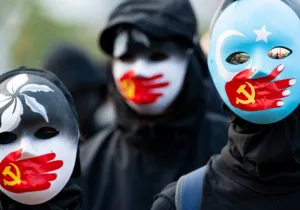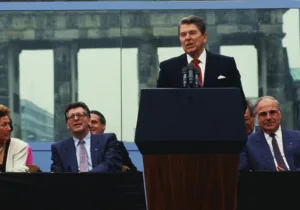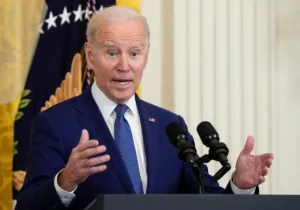A ghost that Chinese people are both familiar with and fearful of—a state-controlled supply and marketing system— has recently returned to the forefront of their minds. On Oct. 23, 2022, one day after the closing of the Chinese Communist Party’s (CCP) 20th National Congress, China’s central authorities announced the 2023 civil service exams, where the All-China Federation of Supply and Marketing Cooperatives is planning to significantly expand by recruiting more young people.
In November 1949, after finally cementing control of China after decades of civil war, the CCP set up the Central Cooperative Administration, followed by the founding of the All-China Federation of Cooperatives in July 1950, which included production cooperatives, credit unions, and the resurgent subject of Chinese anxiety: Supply and Marketing Cooperatives (SMCs).
At the time, the SMCs, which ostensibly required farmers to buy shares and promised dividends, were in fact a copy of Soviet cooperatives. It was a transitional stage in preparation for an economy modeled on collective ownership—the collective farm, known in China as the people’s commune. Over time, the SMC system was further transformed from collective ownership to state ownership. The supply and marketing agency operated the centralized purchasing and marketing system.
In China’s reform and opening-up era, the SMCs faded amid market-oriented reforms. Toward the end of Hu Jintao’s rule in 2012, the SMC had basically shrunk to a symbolic agricultural service organization.
However, after Xi Jinping took power, the SMC began gradually returning to the forefront. SMCs have since flourished throughout the country, though without much fanfare until recently. The Chinese people can only hope the new SMC system has learned from the experience of cooperatives in foreign countries and will not regress to the failed model of the Maoist planned economy.
In particular, Chinese scholars view Japanese agricultural cooperatives (JACs) favorably. They are impressed by their tough attitude towards the Japanese government and insistence on defending the interests of farmers as expressed, for example, through the anti-TPP rally led by the JACs. However, most are unaware that JACs were once a war tool of the militarist Empire of Japan.
JACs were established and supported by the Japanese government in the early 20th century. Then, when Japan became involved in WWII, the militarist government mobilized and forced all farmers to join JACs to contribute food and war materials to the state. At the time, JACs acted as an agency of the Japanese state. Fortunately, following Japan’s democratization after WWII, JACs gained independence and became a powerful advocacy group on behalf of agricultural interests.
Xi’s CCP has demonstrated increasingly alarming militaristic tendencies in both domestic and foreign policy. Under such circumstances, will China’s SMCs follow the example of JACs as a war tool under Imperial Japan? The following signs are worth noting.
Since 2012 when SMCs began their revival under Xi, and especially since 2018 when they reappeared in the news after many years, they have quietly regained coverage of 95% of the countryside.
In June 2021, “Regulations on Supply and Marketing Cooperatives” were included in the “State Council’s 2021 Legislative Work Plan.” In November 2021, the CCP accelerated the reconstruction of SMCs. In October 2022, it announced that more than 1,300 grassroots SMC agencies had been restored in Hubei Province, covering all of the province’s townships and tallying over 450,000 employees.
There are now many SMC propaganda posters not only in townships but also in major cities like Beijing, a startling flashback to the China of half a century ago. It’s foreseeable that, after full coverage of the countryside, SMCs will spread even faster in the cities.
Many believe that Xi’s revival of SMCs is the result of China’s failure to integrate into the international community. It’s also thought that China’s decoupling from the United States is a foregone conclusion and that China must return to a planned economy and impose material controls to prevent social collapse.
However, a review of the re-emergence of the SMC reveals that the agency’s resurgence was determined long before the arrival of external pressures like the U.S.-China trade war, the Hong Kong democracy movement, the pandemic, the potential food crisis, and U.S.-China technological decoupling. Rather, every time external pressures emerge, the growth of the SMC accelerates.
One logical inference is that the resurgence of the SMC is meant to serve both a long-term and an emergency function. In the long term, it will help the government transition the economy to a greater degree of state control in times of peace to secure the “Chinese path to modernization,” i.e., achieving China’s modernization under the condition of two securities—Xi’s grip on power and the CCP’s rule. And, in the case of emergency, when extraordinary circumstances such as pandemics, wars, international sanctions and embargoes are encountered, the corresponding emergency measures will be activated.
Xi Jinping’s ambition to unify Taiwan—by force, if necessary—is undoubted. And his re-crowning at the 20th National Congress has made him ever more confident and determined. The Civilian-Military Fusion Committee and the reforms in the People’s Liberation Army (PLA) in the past few years have been very important measures in preparing for war. There is a Chinese saying, “Before the troops move, food and provisions go first.” Once the CCP starts to carry out war-ready reforms for the whole society, such as the restoration of SMCs, the world should be on high alert that China is gearing up to launch a military invasion of Taiwan.







 Live in the DC area? Sign-up for Providence's in-person events list!
Live in the DC area? Sign-up for Providence's in-person events list!